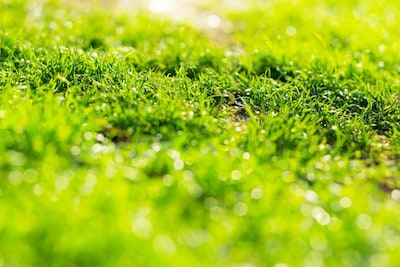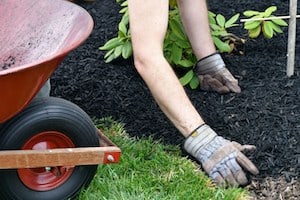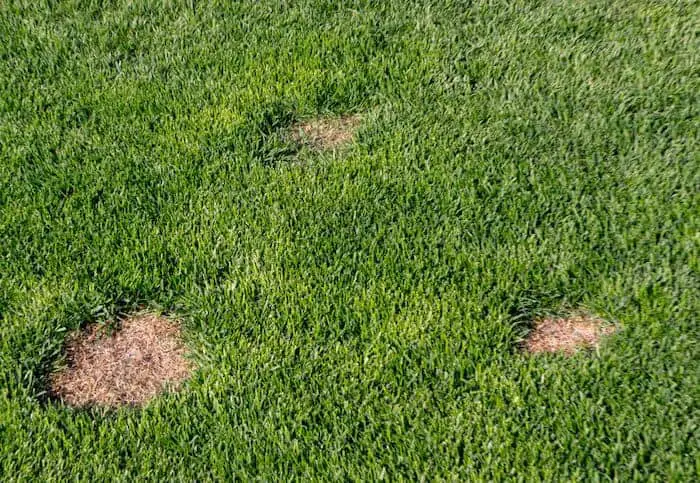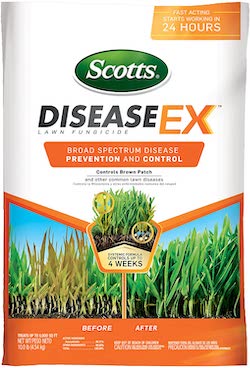10 Steps to Remove Brown Patch Fungus in Your Lawn
Brown patch fungus in lawns is a common problem that can be caused by many different factors. I’ve seen brown patches in a variety of lawns and grass types.
So you may be asking what causes Brown Patch Fungus? The most common cause of brown patch disease is overwatering, which encourages the growth of fungal spores and bacteria. Brown patch fungi are also encouraged to grow when there is too much nitrogen or phosphorus in the soil. These conditions often occur because homeowners fertilize their lawns with large amounts of these nutrients after they receive advice from unknowledgeable individuals.
Other problems include compacted soils, over-fertilization, poor drainage, and lack of aeration – all of which can lead to brown patches on your lawn!
How Do I Identify Brown Patch Fungus?
Brown patch fungus can be identified by the dark brown, sometimes circular patches several feet in diameter that will develop on your lawn. The most obvious sign that your lawn has brown patch is the many dead or dying spots in your grass where there’s a definite change of color from healthy green to unhealthy brown.
Brown Patch Fungus thrives in warm weather and moist conditions so it can easily spread throughout an entire yard if you don’t take steps quickly enough! Try not to let water pool for extended periods near infected areas or over-watering as they are both very common causes of this type of turf disease. If you’re unsure whether your lawn has been invaded with brown patch fungi, get help right away before it spreads too far through the rest of your yard!
What Are the Types of Lawns Brown Patch Fungus Can Affect?
Brown Patch Fungus is most common in Kentucky Bluegrass, Tall Fescue, and Fine-Leaf Fescues, but it will also occasionally show up in Bentgrasses. If your area has any other type of grasses or vegetation they could still be at risk despite not being specifically mentioned.
Brown patch fungi is a tricky disease that’s difficult to recognize until it starts showing its symptoms so you need to take steps as soon as possible if you want to prevent this invasive problem from spreading further into your yard.

Can My Lawn Recover from Brown Patch?
Brown Patch Fungus is a disease that can destroy lawns and many homeowners find it difficult to get rid of. Can my lawn recover from brown patch fungus? Yes, there are some ways for you to keep the problem from getting worse in your yard.
Preventative measures like using fungicides on your grass or rotating areas where you fertilize will help stop brown patch fungus before it has a chance to really take root in your lawn.
There’s no guarantee that this type of treatment will work if Brown Patch is already prevalent throughout the lawn but never underestimate its powers for spreading! Regular mowing at appropriate heights also helps avoid problems with brown patch fungi because they don’t have anything left to feed off when the blades cut through them very close to the ground.
What Is the Best Treatment for Brown Patch Fungus?
The most effective way that I’ve found to treat Brown Patch Disease in your lawn is by using fungicides that have been specifically created for this type of turf disease. For best results, apply them twice a year and make sure you mow your grass at an appropriate height to prevent it from spreading during the cool season!
This will help keep the problem from getting worse and give those fungi less food to eat even if they’re already present in certain parts of your yard. One-time treatments won’t be as successful because once these types of plants start feeding off something else’s roots or leaves, they’ll quickly find their way back again so prevention is key when dealing with Brown Patch Fungus!
First, spot spray affected areas with a fungicide containing benomyl or copper sulfate (overdosing can cause damage). Follow this up by applying lime sulfur as it’s less likely for new patches in nearby grass to develop if you do so. You may also apply chlorothalonil at this time but be careful not to overspray. Be sure to read instructions carefully before using any products.
How Long Does it Take for Brown Patch to Heal?
Brown patch is a tough opponent to beat but it does take time to heal. You should be able to see the brown patches start turning into healthy green grass again after 14 to 28 days. You might even notice that they’re shrinking in size as well! If things aren’t going so well, try reseeding your lawn with new cuttings of Kentucky Bluegrass, Tall Fescue, or Fine-Leaf Fescues.
How Do You Prevent Brown Patch Fungus?
Here are 10 ways to keep your grass healthy and prevent brown patches from forming.
Step One: Mow your grass to the proper height of three inches or less.
The best time to mow is when you notice brown spots appearing on your lawn so that you can cut back any infected portions before they spread – this will also encourage lush, new growth. Do not wait for a major infection before cutting it down because some sections may die and be replaced by fungus spores! If there are too many patches then do not use fertilizer as this could cause more problems with the overgrowth of pathogens in your yard.
Step Two: Fertilize every four weeks as needed.
However, it’s important to remember that fertilizers should only be applied after testing the soil for nitrogen content and pH levels first; otherwise, fungi will grow much more rapidly.
Step Three: Check for compaction in your soil.
Take measures to alleviate it if you find any compaction in your soil to prevent brown patches. This will help the yard get better oxygen levels, which is important because fungus thrives on stagnant areas that have low air flow. Aerate your lawn with a core aerator or power rake after every five years.
Do not use weed killers near compost piles as this can cause more brown patch problems when weeds kill off other plants nearby – allowing fungi to grow even faster!
Step Four: Avoid using broadleaf herbicides such as products containing atrazine during the summer months.
Avoid using broadleaf herbicides such as products containing atrazine during the summer months. The time of year when there are increased outbreaks is usually the same time that you’re spraying for weeds with an herbicide like this, which means they’ll have a greater chance of penetrating deep into the lawn’s soil where it can come back up later.
Step Five: Water only when necessary; otherwise water once or twice a week.
If you have a sprinkler system, use it sparingly and only when necessary. Don’t let water sit on your lawn for long periods of time (such as from rain or irrigation). Remember to check the air conditioner in your home for leaks! Fungi love moisture as we do – if there’s any leak coming out of your AC unit into your yard, chances are that brown patch will take hold easily because those moist conditions are perfect breeding grounds.
Step Six: Consider adding some organic matter to your soil such as compost or mulch
This will help create better air circulation in the yard and also add nutrients back into it. Compost is a great organic material that can be added to your lawn. It’s made by combining layers of green and brown materials like grass clippings, leaves, or hay with soil and other ingredients such as manure, shredded newspaper or eggshells.
Adding compost will help keep the weeds down because it will increase nutrient levels in the soil which makes the environment too acidic for them to grow successfully (due to higher concentrations of nutrients).
The materials in compost break down slowly so it will also help your lawn stay cooler during the summer months because there is less of a need for watering.
Cooler soil means that you’ll have to water less often too, which helps conserve resources and energy! Composting also supplies an abundance of organic material back into the soil which provides nutrients essential for healthy turfgrass growth.
Step Seven: Avoid excessive fertilization with products that contain nitrogen or phosphorus.
These nutrients encourage fungal spores that cause brown patches on your lawns. If you must add fertilizer, wait until spring when fungi levels are lower and use only non NPK (nitrogen, phosphorus) type fertilizer like bone meal instead.
Step Eight: Make sure you have an adequate amount of drainage installed by digging trenches around your lawn.
This is most important in areas where water from gutters tends to pool after rainstorms. Check for proper grading before installing new turf so water doesn’t accumulate excessively on one side of the yard. The other step is making sure debris does not pile up near trees when they shed leaves because this creates extra food sources for fungi growth including brown patch disease
Step Nine: Keep your lawn free of debris by mowing and raking regularly.
Keeping your lawn free of debris will also help keep the soil healthy. Remove any diseased leaves from your yard (especially during fall). This will help prevent spores from being released which could reinfect other areas of your yard. Be careful not to spread infected debris over healthy sections of turfgrass or into gardens and flowerbeds nearby.
Step Ten: Add some more organic matter such as mulch or compost around trees where leaves tend to pile up naturally.
This will prevent moisture from accumulating and forming a perfect breeding ground for brown patches. Keep in mind that fungi also love the shade, so make sure to check under your trees as well. Brown Patch Disease may start with just one or two patches of grass affected, but if you don’t act quickly it can spread through your whole yard. If left untreated, brown patch disease causes white mycelium to form on top of the turfgrass blades which is not only unsightly – this fungal infestation could kill sections of your green lawn too!
Brown patches usually begin showing up in the summer months because at this time there are higher concentrations of water (due to humidity) where fungi like best.
 Related Questions
Related Questions
What Kills Lawn Fungus?
The best way to get rid of brown patches on lawns is through the application of fungicide. There are a variety of products available for this purpose, some like granular that you can sprinkle over your grass or liquid applications which will have a more penetrating power.
If the infestation is not far-reaching and localized, consider using an organic solvent such as neem oil spray (found in nurseries). Neem oil contains natural compounds which effectively inhibit spore germination and cause fungal strands to flake off. Make sure to always read directions carefully before applying any type of treatment!
Maintaining a balanced lawn will help minimize any chance of developing the fungal condition due to its ability to survive well under conditions where nitrate levels are high or oxygen content is low. If you notice any signs of the infection get help immediately! If you’re unable to get the brown patch disease under control then contact an expert who will be able to assess your yard specifically and provide treatment advice as needed. Be sure to follow their instructions closely and maintain healthy practices going forward so as not to risk recurring infections in the future.


